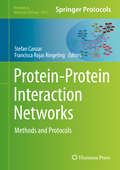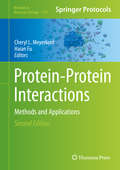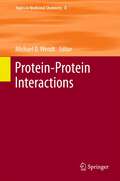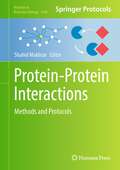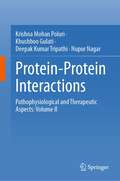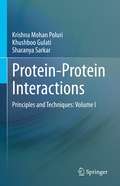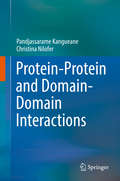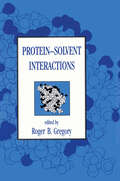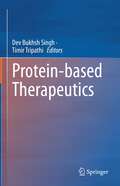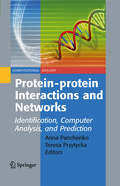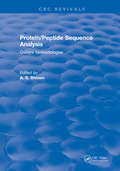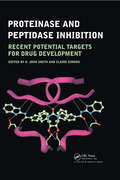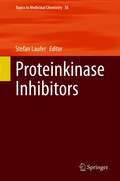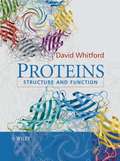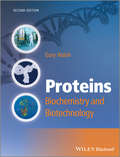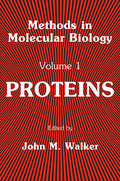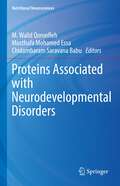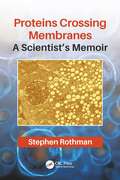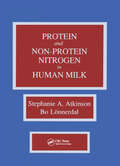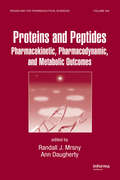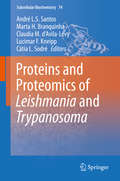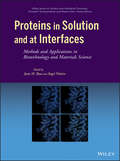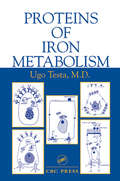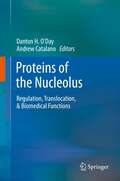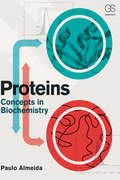- Table View
- List View
Protein-Protein Interaction Networks: Methods and Protocols (Methods in Molecular Biology #2074)
by Stefan Canzar Francisca Rojas RingelingThis volume explores techniques that study interactions between proteins in different species, and combines them with context-specific data, analysis of omics datasets, and assembles individual interactions into higher-order semantic units, i.e., protein complexes and functional modules. The chapters in this book cover computational methods that solve diverse tasks such as the prediction of functional protein-protein interactions; the alignment-based comparison of interaction networks by SANA; using the RaptorX-ComplexContact webserver to predict inter-protein residue-residue contacts; the docking of alternative confirmations of proteins participating in binary interactions and the visually-guided selection of a docking model using COZOID; the detection of novel functional units by KeyPathwayMiner and how PathClass can use such de novo pathways to classify breast cancer subtypes. Written in the highly successful Methods in Molecular Biology series format, chapters include introductions to their respective topics, lists of the necessary hardware- and software, step-by-step, readily reproducible computational protocols, and tips on troubleshooting and avoiding known pitfalls.Cutting-edge and comprehensive, Protein-Protein Interaction Networks: Methods and Protocols is a valuable resource for both novice and expert researchers who are interested in learning more about this evolving field.
Protein-Protein Interactions
by Haian Fu Cheryl L. MeyerkordThe second edition covers a wide range of protein-protein interaction detection topics. Protein-Protein Interactions: Methods and Applications focuses on core technological platforms used to study protein-protein interactions and cutting-edge technologies that reflect recent scientific advances and the emerging focus on therapeutic discovery. Written in the highly successful Methods in Molecular Biology series format, chapters include introductions to their respective topics, lists of necessary materials and reagents, step-by-step laboratory protocols, and tips on troubleshooting and avoiding known pitfalls. These well-detailed protocols describe methods for identifying protein-protein interaction partners, analyzing of protein-protein interactions quantitatively and qualitatively, monitoring protein-protein interactions in live cells, and predicting and determining interaction interfaces. Authoritative and cutting-edge, Protein-Protein Interactions: Methods and Applications, Second Edition is a valuable resource that will enable readers to elucidate the mechanisms of protein-protein interactions, determine the role of these interactions in diverse biological processes, and target protein-protein interactions for therapeutic discovery.
Protein-Protein Interactions
by Michael D. WendtMichael D. Wendt Protein-Protein Interactions as Drug Targets Shaomeng Wang , Yujun Zhao , Denzil Bernard , Angelo Aguilar , Sanjeev Kumar Targeting the MDM2-p53 Protein-Protein Interaction for New Cancer Therapeutics Kurt Deshayes , Jeremy Murray , Domagoj Vucic The Development of Small-Molecule IAP Antagonists for the Treatment of Cancer John F. Kadow , David R. Langley , Nicholas A. Meanwell , Michael A. Walker , Kap-Sun Yeung , Richard Pracitto Protein-Protein Interaction Targets to Inhibit HIV-1 Infection Nicholas A. Meanwell , David R. Langley Inhibitors of Protein-Protein Interactions in Paramyxovirus Fusion - a Focus on Respiratory Syncytial Virus Andrew B. Mahon , Stephen E. Miller , Stephen T. Joy , Paramjit S. Arora Rational Design Strategies for Developing Synthetic Inhibitors of Helical Protein Interfaces Michael D. Wendt The Discovery of Navitoclax, a Bcl-2 Family Inhibitor
Protein-Protein Interactions: Methods and Protocols (Methods in Molecular Biology #2690)
by Shahid MukhtarThis detailed volume provides a comprehensive collection of classic and cutting-edge methods and techniques in mapping protein-protein interactions. The chapters include a variety of in vitro and in vivo experimental methods covering cell biology, biochemistry, and biophysics. In addition, the book also explores in silico methods including sequence-, structure-, and phylogenetic profile-based approaches as well as gene expression and machine learning methods. Written for the highly successful Methods in Molecular Biology series, chapters include introductions to their respective topics, lists of the necessary materials and reagents, step-by-step and readily reproducible laboratory protocols, as well as tips on troubleshooting and avoiding known pitfalls. Authoritative and practical, Protein-Protein Interactions: Methods and Protocols serves as an ideal guide for researchers working in protein science and beyond.
Protein-Protein Interactions: Pathophysiological and Therapeutic Aspects: Volume II
by Krishna Mohan Poluri Khushboo Gulati Deepak Kumar Tripathi Nupur NagarThe second volume of the book-Protein-Protein Interactions (PPIs) provides an overview of various protein-protein interactions (PPIs) that are involved in various human diseases including cancer, neurodegenerative diseases, immune diseases, and inflammation. It summarizes the structure and ligand-based drug designing approaches for the discovery of small molecules that can inhibit PPIs in these diseases. The book discusses different computational and experimental tools that are used to determine the anomalous interactions underlying the diseases. Lastly, it also reviews the classical interactions between pathogens and hosts that are responsible for the pathophysiology of infectious diseases.
Protein-Protein Interactions: Principles and Techniques: Volume I
by Krishna Mohan Poluri Khushboo Gulati Sharanya SarkarThis book provides a comprehensive overview of the fundamental aspects of protein-protein interactions (PPI), including a detailed account of the energetics and thermodynamics involved in these interactions. It also discusses a number of computational and experimental approaches for the prediction of PPI interactions and reviews their principles, advantages, drawbacks, and the recent developments. Further, it offers structural and mechanistic insights into the formation of protein-protein complexes and maps different PPIs into networks to delineate various pathways that operate at the cellular level. Lastly, it describes computational protein-protein docking techniques and discusses their implications for further experimental research. Given its scope, this book is a valuable resource for students, researchers, scientists, entrepreneurs, and medical/healthcare professionals.
Protein-Protein and Domain-Domain Interactions
by Pandjassarame Kangueane Christina NiloferThis book illustrates the importance and significance of the molecular (physical and chemical) and evolutionary (gene fusion) principles of protein-protein and domain-domain interactions towards the understanding of cell division, disease mechanism and target definition in drug discovery. It describes the complex issues associated with this phenomenon using cutting edge advancement in Bioinformatics and Bioinformation Discovery. The chapters provide current information pertaining to the types of protein-protein complexes (homodimers, heterodimers, multimer complexes) in context with various specific and sensitive biological functions. The significance of such complex formation in human biology in the light of molecular evolution is also highlighted using several examples. The chapters also describe recent advancements on the molecular principles of protein-protein interaction with reference to evolution towards target identification in drug discovery. Finally, the book also elucidates a comprehensive yet a representative description of a large number of challenges associated with the molecular interaction of proteins.
Protein-Solvent Interactions
by Roger B. GregoryThis work covers advances in the interactions of proteins with their solvent environment and provides fundamental physical information useful for the application of proteins in biotechnology and industrial processes. It discusses in detail structure, dynamic and thermodynamic aspects of protein hydration, as well as proteins in aqueous and organic solvents as they relate to protein function, stability and folding.
Protein-based Therapeutics
by Dev Bukhsh Singh Timir TripathiThis book provides an overview of the essential characteristics and clinical applications of therapeutic proteins against human diseases, including cancers, immune disorders, infections, and other diseases. It presents the latest advancements in protein engineering techniques for producing desirable therapeutic proteins. The book also covers the strategies used to formulate and deliver systemic therapeutic proteins, approved protein therapeutics and their targets, and pharmacogenetic biomarkers. Further, it discusses challenges associated with the clinical implications of therapeutic proteins, including safety, immunogenicity, protein stability, degradation, and efficacy. It illustrates the development of biosimilar antibodies, optimization strategies for producing biobetter antibodies, and presents fundamental concepts about biosuperior therapeutics. Lastly, it includes a discussion about protein-based vaccines against bacterial and viral infections.
Protein-protein Interactions and Networks
by Anna Panchenko Teresa M. PrzytyckaThe biological interactions of living organisms, and protein-protein interactions in particular, are astonishingly diverse. This comprehensive book provides a broad, thorough and multidisciplinary coverage of its field. It integrates different approaches from bioinformatics, biochemistry, computational analysis and systems biology to offer the reader a comprehensive global view of the diverse data on protein-protein interactions and protein interaction networks.
Protein/Peptide Sequence Analysis: Current Methodologies
by A.S. BhownThis book is an attempt to provide in a single source current state-of-the-art methodologies for protein sequence analysis. It is hoped that these various chapters are presented in such a way that both the newcomer and the established protein chemist will find useful information and directions to new techniques. This book offers a rich array of techniques and methods for sequencing proteins and peptides. It should meet the expectations of investigators in protein chemistry who wish to update their knowledge of sequencing techniques, and of those who wish to reacquaint themselves with the best available current technologies.
Proteinase and Peptidase Inhibition: Recent Potential Targets for Drug Development
by H. John Smith Claire SimonsCellular proteinases and their physiological role in normal and disease states have been the subject of great interest recently. Proteinase and Peptidase Inhibition presents new reports on a wide range of cellular proteinases whose inhibitors may hold the key to the development of new drugs. It deals with enzyme classes, inhibitor types and regulatory mechanisms governing proteinase activity. Target enzymes are fully described and classified by structural similarity, rather than by pharmacological effects. This is a valuable reference for academic and industrial researchers in medicinal chemistry, drug design and development, pharmacology, biochemistry, and molecular and cell biology.
Proteinkinase Inhibitors (Topics in Medicinal Chemistry #36)
by Stefan LauferThis book reviews the principles of design and examples of successful implementation of proteinkinase inhibitors (PKI), and offers a comprehensive and authoritative overview of the history and latest developments in the field. Chapters written by experts from industry and academia cover the function, structure and topology of Proteinkinases, molecular modelling, disclose how to achieve high level of selectivity for kinase inhibitors, and exploit kinase inhibitors for cancer treatment. Particular attention is given to Inhibitors of c-Jun N-terminal kinase 3, and to covalent Janus Kinase 3 Inhibitors. A case study on Receptor Tyrosine Kinases EGFR, VEGFR, PDGFR is also presented in this book.Given its breath, this book will appeal to medicinal chemists, students, researchers and professionals alike.
Proteins
by David WhitfordProteins: Structure and Function is a comprehensive introduction to the study of proteins and their importance to modern biochemistry. Each chapter addresses the structure and function of proteins with a definitive theme designed to enhance student understanding. Opening with a brief historical overview of the subject the book moves on to discuss the 'building blocks' of proteins and their respective chemical and physical properties. Later chapters explore experimental and computational methods of comparing proteins, methods of protein purification and protein folding and stability.The latest developments in the field are included and key concepts introduced in a user-friendly way to ensure that students are able to grasp the essentials before moving on to more advanced study and analysis of proteins.An invaluable resource for students of Biochemistry, Molecular Biology, Medicine and Chemistry providing a modern approach to the subject of Proteins.
Proteins
by Gary WalshProteins Biochemistry and Biotechnology 2e is a definitive source of information for all those interested in protein science, and particularly the commercial production and isolation of specific proteins, and their subsequent utilization for applied purposes in industry and medicine.Fully updated throughout with new or fundamentally revised sections on proteomics as, bioinformatics, protein glycosylation and engineering, well as sections detailing advances in upstream processing and newer protein applications such as enzyme-based biofuel production this new edition has an increased focus on biochemistry to ensure the balance between biochemisty and biotechnology, enhanced with numerous case studies.This second edition is an invaluable text for undergraduates of biochemistry and biotechnology but will also be relevant to students of microbiology, molecular biology, bioinformatics and any branch of the biomedical sciences who require a broad overview of the various medical, diagnostic and industrial uses of proteins. * Provides a comprehensive overview of all aspects of protein biochemisty and protein biotechnology* Includes numerous case studies * Increased focus on protein biochemistry to ensure balance between biochemisty and biotechnology* Includes new section focusing on proteomics as well as sections detailing protein function and enzyme-based biofuel production"With the potential of a standard reference source on the topic, any molecular biotechnologist will profit greatly from having this excellent book. " (Engineering in Life Sciences, 2004; Vol 5; No. 5)"Few texts would be considered competitors, and none compare favorably." (Biochemistry and Molecular Education, July/August 2002) "...The book is well written, making it informative and easy to read..." (The Biochemist, June 2002)
Proteins
by John M. WalkerOffers over 200 key, readily reproducible protocols that ensure robust, successful results Includes many new techniques for the study of post-translational modifications Demonstrates the range of techniques available and their strengths and limitations Contains numerous time-saving techniques for even the most highly skilled researchers Since the publication of the bestselling second edition of John Walkers widely acclaimed Protein Protocols Handbook, there have been continual methodological developments in the field of protein chemistry. This greatly enhanced third edition introduces 57 critically important new chapters, as well as significantly updating the previous editions tried-and-true methods. Although the timely new chapters are spread throughout all of the book, the vital section on post-translational modifications has been expanded most to reflect the increasing importance of these modifications in the understanding of protein function. Each readily reproducible method follows the highly praised format of the Methods in Molecular BiologyT series, offering a concise summary of its basic theory, a complete materials list, a step-by-step protocol for its successful execution, and extensive notes on avoiding pitfalls, or on modifying the method to function within your own experimental circumstances. The expert authors of each chapter have demonstrated a hands-on mastery of the methods described, fine-tuned here for optimal productivity. Comprehensive, cutting-edge, and highly practical, The Protein Protocols Handbook, Third Edition is todays indispensable benchtop manual and guide, not only for all those new to the protein chemistry laboratory, but also for those established workers seeking to broaden their armametarium of techniques in the urgent search for rapid and robust results.
Proteins Associated with Neurodevelopmental Disorders (Nutritional Neurosciences)
by M. Walid Qoronfleh Musthafa Mohamed Essa Chidambaram Saravana BabuThis book comprehensively reviews the proteins associated with neurodevelopmental disorders, including autism spectrum disorder (ASD) and attention deficit hyperactivity disorder (ADHD). It also discusses the interactions of the associated-proteins, like bromodomain-containing proteins (BCPs), kinases, synaptic proteins, scaffolding proteins, transcriptional factors, and DNA-binding proteins at the subcellular and molecular levels. The book also explores the potential of these proteins as a druggable target and a biomarker in the neurodevelopmental disorders. The book further explores the recent advancements in understanding the important role of epigenetic factors in predisposition to these diseases. Lastly, it presents genetic factors that lead to variation in gene expression in these diseases, disorders management via diet intervention and the future potential of stem cell therapy.
Proteins Crossing Membranes: A Scientist’s Memoir
by Stephen RothmanIn an intriguing series of experiments carried out many years ago, a common scientific belief, feted by no less than three Nobel prizes, was brought into question. The observations were about proteins—the molecules that the genetic code specifies and that are in one way or another central to all of life’s activities. The experiments however were not about what proteins do, but how they are moved, in particular how they are moved from where they are made to where they act. The results of these studies conflicted with the standard view of how this happens, and thus became controversial. The standard view, the vesicle theory of protein secretion, envisions proteins being carried within and out of cells en masse in membrane-bound sacs or vesicles. The controversial experiments demonstrated that to the contrary individual protein molecules cross the relevant membranes as a result of their own motion. This was thought to be impossible at the time. Proteins Crossing Membranes is a personal narrative that tells the story of the controversy. Among other things, the author illustrates that scientists, like the rest of us, can rigidly hold onto their beliefs despite evidence that they are misguided. Key Features Reviews the data in support and critical of the vesicle theory of protein secretion Explores the ways scientists respond to evidence that challenges a favored theory Documents the author’s personal experiences in this conflict-laden situation
Proteins and Non-protein Nitrogen in Human Milk
by Stephanie Atkinson Bo LonnerdalFor the first time, an entire publication has been dedicated to providing a critical review of the identification and analysis of the milk specific proteins such as lactalbumin, lactoferrin and casein; the non-milk specific proteins such as plasma and membrane proteins; and the minor nitrogen-containing components such as enzymes, hormones, and growth factors. Biological roles, whether nutritional, endocrinological or immunological, of the specific nitrogen compounds in mammary milk production and/or growth and development of the breast-fed infant are also presented. Identification of the molecular weight compounds that have led to questions about their function in milk and their inclusion in modern infant formulas is thoroughly discussed and of great value to scientists in sub-specialties of biochemistry, nutrition, physiology and immunology, as well as to pediatric practitioners with primary interests in the infant food industry, academia, or clinical nutrition. The thoroughness of each chapter, often providing an historical panorama of the specific aspect of milk composition, makes this book useful for both the uninitiated and expert audiences who are interested in advancing their knowledge of human milk biochemistry and its physiological significance to the recipient infant.
Proteins and Peptides: Pharmacokinetic, Pharmacodynamic, and Metabolic Outcomes (Drugs and the Pharmaceutical Sciences)
by Randall J. Mrsny Ann DaughertyAddressing the increased use of protein and peptide candidates as treatments for previously untreatable diseases, this comprehensive and progressive source provides the reader with a roadmap to an increased understanding of issues critical for successfully developing a protein or peptide therapeutic candidate. Proteins and Peptides is
Proteins and Proteomics of Leishmania and Trypanosoma
by André L. S. Santos Marta H. Branquinha Claudia M. d'Avila-Levy Lucimar F. Kneipp Cátia L. SodréThis book contains a collection of critical reviews on the expression of biologically functional proteins in Leishmania and Trypanosoma, which was written by renowned researchers on this field. Species belonging to these trypanosomatids' genera are etiological agents of leishmaniasis, Chagas' disease and sleeping sickness that are extremely debilitating human infection diseases, which remain a major health problem especially in countries from Latin America, Africa and Middle East. Substantiating the problem, the currently accepted drugs for these diseases are quiet unsatisfying due to their low efficacy and high toxicity. In order to solve these real problems, several research groups around the world have become involved in the study and identification of novel potential targets in the trypanosomatid cell. Since proteins are key macromolecules involved in crucial metabolic processes of all living cells, studies have focused on the expression of specific proteins produced by Leishmania and Trypanosoma by means of different biochemical, molecular and proteomic approaches in order to explore them as targets for understanding the parasite life cycle and developing new strategies against trypanosomiasis. With these proposals in mind, the book "Proteins and Proteomics of Leishmania and Trypanosoma" encompasses (i) an integrated view about the biochemistry of parasites belonging to the Leishmania and Trypanosoma genera; (ii) an updated review on the expression of biologically relevant proteins by human pathogenic trypanosomatids and their possible role in the interaction with host cells/molecules as well as a target for development of both alternative chemotherapies and vaccine; and (iii) several pictures, diagrams and tables that can be used to illustrate both undergraduate and postgraduate teaching as well as scientific lectures, being a useful resource for students and researchers.
Proteins in Solution and at Interfaces
by Ángel Piñeiro Juan M. RusoExplores new applications emerging from our latest understanding of proteins in solution and at interfacesProteins in solution and at interfaces increasingly serve as the starting point for exciting new applications, from biomimetic materials to nanoparticle patterning. This book surveys the state of the science in the field, offering investigators a current understanding of the characteristics of proteins in solution and at interfaces as well as the techniques used to study these characteristics. Moreover, the authors explore many of the new and emerging applications that have resulted from the most recent studies. Topics include protein and protein aggregate structure; computational and experimental techniques to study protein structure, aggregation, and adsorption; proteins in non-standard conditions; and applications in biotechnology.Proteins in Solution and at Interfaces is divided into two parts:Part One introduces concepts as well as theoretical and experimental techniques that are used to study protein systems, including X-ray crystallography, nuclear magnetic resonance, small angle scattering, and spectroscopic methodsPart Two examines current and emerging applications, including nanomaterials, natural fibrous proteins, and biomolecular thermodynamicsThe book's twenty-three chapters have been contributed by leading experts in the field. These contributions are based on a thorough review of the latest peer-reviewed findings as well as the authors' own research experience. Chapters begin with a discussion of core concepts and then gradually build in complexity, concluding with a forecast of future developments.Readers will not only gain a current understanding of proteins in solution and at interfaces, but also will discover how theoretical and technical developments in the field can be translated into new applications in material design, genetic engineering, personalized medicine, drug delivery, biosensors, and biotechnology.
Proteins of Iron Metabolism
by Ugo TestaProteins of Iron Metabolism presents a clear picture of the structure and function of the main proteins involved in iron metabolism. The book gives you a detailed description of the structure and function of each protein, and discusses the structure and regulation of the corresponding genes in parallel. It supplies an analysis of the differential e
Proteins of the Nucleolus
by Andrew Catalano Danton H O'DayThis book contains 14 original review chapters each yielding new, exciting and intriguing data about the emerging understanding of nucleolar structure and function in normal, stressed and diseased cells. The goal of this work is to provide special insight into the nucleolus of the past, present and future, as well its regulation, translocation, and biomedical function. A multitude of topics are introduced and discussed in detail, including nucleologenesis, nucleolar architecture, nucleolar targeting, retention, anchoring, translocation, and the relationship between the nucleolus and cancer. This book also brings together work from several different species, from human to Drosophila to Dictyostelium and other eukaryotic microbes. The final chapter summarizes some of the issues brought up in the various chapters with a view to future research. This book supports the continued emergence of the nucleolus as a dynamic intranuclear region that oversees a vast diversity of events.
Proteins: Concepts in Biochemistry
by Paulo AlmeidaProteins: Concepts in Biochemistry teaches the biochemical concepts underlying protein structure, evolution, stability and folding, and explains how interactions with macromolecular structures determine protein function. Intended for a one-semester biochemistry course with a focus on proteins, this textbook emphasizes the logic underlying biophysical chemical principles. Problems throughout the book encourage statistical and quantitative thinking. The text is ideal for senior undergraduates, first year graduate students, and practitioners in chemistry, biochemistry, biology, and biophysics.
